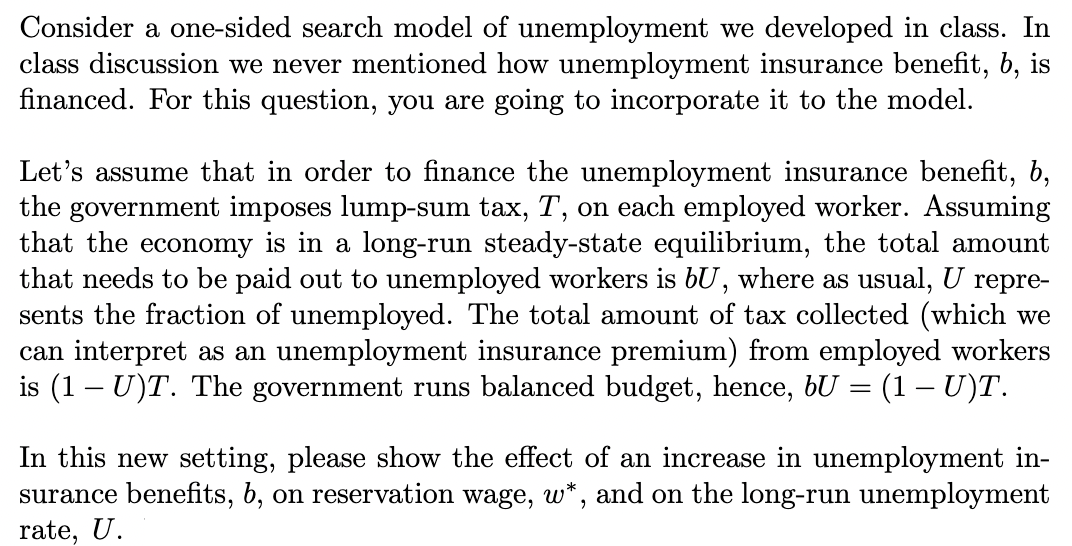Consider a one-sided search model of unemployment we developed in class. In class discussion we never mentioned how unemployment insurance benefit, b, is financed. For this question, you are going to incorporate it to the model. Let's assume that in order to finance the unemployment insurance benefit, b, the government imposes lump-sum tax, T, on each employed worker. Assuming that the economy is in a long-run steady-state equilibrium, the total amount that needs to be paid out to unemployed workers is bU, where as usual, U repre-
Consider a one-sided search model of unemployment we developed in class. In class discussion we never mentioned how unemployment insurance benefit, b, is financed. For this question, you are going to incorporate it to the model. Let's assume that in order to finance the unemployment insurance benefit, b, the government imposes lump-sum tax, T, on each employed worker. Assuming that the economy is in a long-run steady-state equilibrium, the total amount that needs to be paid out to unemployed workers is bU, where as usual, U repre-
Chapter18: Introduction To Macroeconomics: Unemployment, Inflation, And Economic Fluctuations
Section: Chapter Questions
Problem 7P
Related questions
Question
please include graphs

Transcribed Image Text:Consider a one-sided search model of unemployment we developed in class. In
class discussion we never mentioned how unemployment insurance benefit, b, is
financed. For this question, you are going to incorporate it to the model.
Let's assume that in order to finance the unemployment insurance benefit, b,
the government imposes lump-sum tax, T, on each employed worker. Assuming
that the economy is in a long-run steady-state equilibrium, the total amount
that needs to be paid out to unemployed workers is bU, where as usual, U repre-
sents the fraction of unemployed. The total amount of tax collected (which we
can interpret as an unemployment insurance premium) from employed workers
is (1U)T. The government runs balanced budget, hence, bU = (1 – U)T.
In this new setting, please show the effect of an increase in unemployment in-
surance benefits, b, on reservation wage, w*, and on the long-run unemployment
rate, U.
Expert Solution
This question has been solved!
Explore an expertly crafted, step-by-step solution for a thorough understanding of key concepts.
This is a popular solution!
Trending now
This is a popular solution!
Step by step
Solved in 4 steps with 2 images

Knowledge Booster
Learn more about
Need a deep-dive on the concept behind this application? Look no further. Learn more about this topic, economics and related others by exploring similar questions and additional content below.Recommended textbooks for you

Exploring Economics
Economics
ISBN:
9781544336329
Author:
Robert L. Sexton
Publisher:
SAGE Publications, Inc


Macroeconomics: Private and Public Choice (MindTa…
Economics
ISBN:
9781305506756
Author:
James D. Gwartney, Richard L. Stroup, Russell S. Sobel, David A. Macpherson
Publisher:
Cengage Learning

Exploring Economics
Economics
ISBN:
9781544336329
Author:
Robert L. Sexton
Publisher:
SAGE Publications, Inc


Macroeconomics: Private and Public Choice (MindTa…
Economics
ISBN:
9781305506756
Author:
James D. Gwartney, Richard L. Stroup, Russell S. Sobel, David A. Macpherson
Publisher:
Cengage Learning

Economics: Private and Public Choice (MindTap Cou…
Economics
ISBN:
9781305506725
Author:
James D. Gwartney, Richard L. Stroup, Russell S. Sobel, David A. Macpherson
Publisher:
Cengage Learning


Economics (MindTap Course List)
Economics
ISBN:
9781337617383
Author:
Roger A. Arnold
Publisher:
Cengage Learning